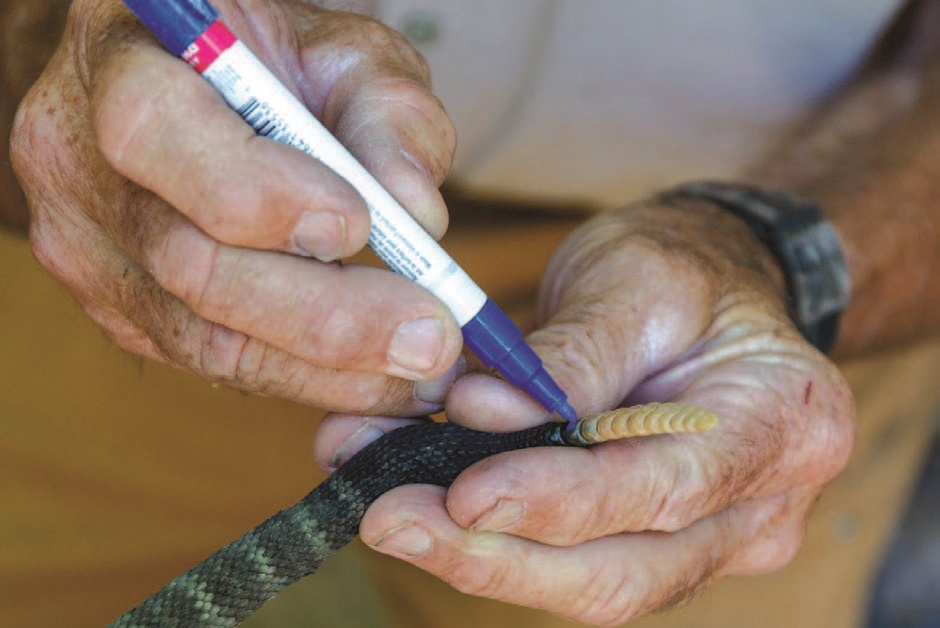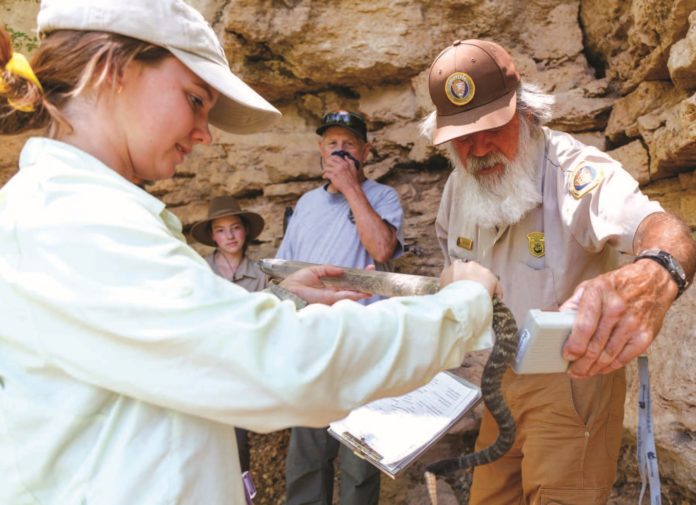Jim Starkey loves snakes. One doesn’t have to make much of an effort to see his enthusiasm for the slithery creatures; from the way he delicately handles dangerous rattlesnakes to his fashion choices, which are never complete without his silver snake belt buckle. Starkey is a bonafide wrangler through-and-through.
For roughly a decade, Starkey has been working with Erika Nowak, Ph.D., a herpetologist at Northern Arizona University, helping to catch and catalog 25 species of snakes as part of Nowak’s mark-recapture program at Montezuma Castle and Tuzigoot National Monuments, as well as Oak Creek Canyon in Sedona.
Of the 25 species of snakes Starkey catalogs, “Five of them are venomous.”
“We’ve got four rattlers in the Verde Valley here, and the Arizona Coral Snake; the rest of them are non-venomous.”
Starkey receives several snake-related calls per month from Montezuma in the weeks leading up to early summer, as the snakes become more active.
To track the snakes, Starkey uses a syringe to implant tiny “pit tags,” or microchips, under their skin, which can then be scanned at a later date if the snake has been recaptured, in order to track their growth and general health.
On June 8, it was a particularly hot morning at Montezuma Well, which is a detached portion of Montezuma Castle National Monument, when Starkey arrived with his kit, ready to inspect a black-tailed rattlesnake that had been captured by one of the monument’s volunteers, Gary Mason, earlier that morning.
Mason, a resident of New York state and retiree, comes “out west” every summer to volunteer. He learned how to handle snakes by taking a snake-handling course from Nowak.
The classes are for volunteers at Montezuma Castle and Tuzigoot, Mason said.
“You don’t have to take it, and you can opt out of it if you don’t want to [handle snakes],” he said.
“She has snakes that you can handle,” he said. “A lot of people decide that it’s not for [them], but I find it fascinating.”
As Starkey readied his kit, a backpack consisting of a variety of tubes for containing snakes, a gripping tool, and other accouterments, a third wrangler arrived — Eve Berlinski.
Berlinski, a graduate student at NAU, has been working with Nowak for the past two years and has been learning the ropes of snake handling, a term she prefers over “wrangler.”
“I’ve learned from working with the public that terminology around snakes is important, because so many people are afraid of them,” Berlinski said. “If you tell people you’re a snake wrangler then they think you’re really ‘wrassling’ them; it’s pretty easy to [catch] them sometimes.”
When the team was ready to perform the inspection, temperatures at the Montezuma parking area, where Starkey usually performs inspections, were already in the 90 degree range and climbing.
Starkey thought it best to take the snake back to the area where it was caught because it was shadier there.
“It’s at least ten degrees cooler down there,” he said, referring to a trail which leads down to Beaver Creek.
While snakes like to be warm, they do have a limit, which is anything over 90 degrees Farenheit.
“I don’t want to cook this guy,” Starkey said.
As Starkey, Mason and Berlinksi set off for the trail, a small crowd followed, eager to catch a glimpse of the rattler, who was contained in a specially-designed ventilated bucket.
“We usually like to do this in full view of the public,” Starkey said. However, for this particular inspection, only volunteers and employees were allowed onto the narrow trail as a precaution.
While disappointed, the onlookers received a consolation prize: The rattler began rattling just as they were walking off, as if to say, “Thank you for your interest.”
Once Starkey had everything situated, he explained his “tubing” method to Berlinski, who had not yet performed the task.
While Berlinski had handled plenty of snakes previously, including Western Diamondback rattlers, this would be her first time getting a snake into a tube for the purpose of inspection.
“I’m not really nervous, but I know it can be kind of tricky,” she said, adding that Nowak taught her “how to handle some venomous snakes.”
“I was actually really surprised when I started working with the rattlesnakes; they’re different than everyone expects,” she said of their relatively docile nature.
“I’ve really enjoyed working with the rattlesnakes, it’s changed my perspective on them and has helped me to be able to tell people that [they’re] not so bad,” she said. “They’re not out there to chase you or attack you.”

Starkey repaints the rattle of a black-tailed rattlesnake (below). Starkey did this after taking the snake’s length and weight. Daulton Venglar/ Larson Newspapers
According to Starkey, the snakes typically don’t bite unless provoked.
“When you approach them in the wild, their first strategy is to remain completely motionless; they’re hoping you won’t see them” he said. “Then, if they feel like they’ve been busted, that’s when they start rattling.”
“That rattle is a stress reaction,” he said. “They’ll usually get into a defensive coil, that allows them to strike out at about half of their body length.”
According to Starkey, the best way to avoid being bitten is to avoid interacting with the snakes.
“They get a bad rap, I think” he said.
According to Nowak’s statistics, 90 percent of bites happen to people who are messing with them.
“If you’re out on the trail and you encounter [a rattlesnake], you may not see it, you’ll more than likely hear it first,” he explained. “The first think you should do is freeze, figure out where it is, and then slowly back away.”
According to Starkey, if you do get bitten, you should stay calm and get to a hospital right away.
The most valuable tool is your car keys,” he said.
Experts do not recommend applying a tourniquet, nor cutting and sucking the venom. Don’t apply ice, but take off jewelry, “because if you did get envenomated you’re going to start swelling,” he said.
Starkey added that modern medicine has evolved when it comes to antivenom technology.
“The hospital will do the blood work, determine the level of envenomation and how many vials of antivenom to give you,” he said.
“It’s an expensive trip to the hospital,” he added. “I wouldn’t recommend it.”
The drugs used to counteract a snakebite cost hospitals between $1,200 and $3,000 per vial, and patients are often charged significantly more than that — as much as 18 times more in at least one case.
While rattlesnake bites are rarely fatal, they can be extremely painful and can cause permanent damage to bodily organs such as the intestines or kidneys.
However, “in most treated cases, people fully recover” according to healthline.com.
Despite the potential dangers involved in working with snakes, Starkey and Berlinski are dedicated to their work with Nowak and continue to spread the word to the public about the importance of snakes as often as they can.
“I want to change people’s minds about snakes,” Berlinski said. “Especially out here; it’s so surprising how little people know about snakes and they’re from Arizona.”
According to the Arizona Game and Fish Department, the state is home to 52 species of snakes, and 13 of those are rattlesnakes, which is just over 1/3 of the world’s rattlesnakes and more than any other state in the U.S.
“I think one of the main reasons why Erika is continuing with this [project] is so that we can do it in front of the public and educate them,” Starkey said. “I think a lot of these wouldn’t get killed if people understood them a little bit better.”
“We definitely come across a lot of people who are very afraid when we tell them we’re working with snakes; they’ll say ‘OK, let me go and get my shovel,’” Berlinski said.
“It’s always helpful to tell people why snakes are important because some people just don’t understand why we need them, but they’re really great rodent control, and also they’re a great species for other animals that people love; so if you want to have bobcats and coyotes, owls and all these beloved animals then you have to have snakes around for that.”



